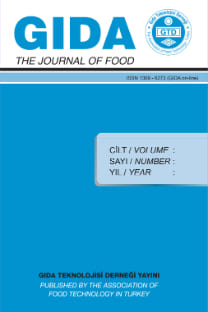DETERMINATION AND OPTIMIZATION OF THE BIOPROCESS PARAMETERS EFFECTING GROWTH OF LACTOBACILLUS SANFRANCISCENSIS
LACTOBACILLUS SANFRANCISCENSIS’İN GELİŞMESİNDE ETKİLİ BİYOPROSES PARAMETRELERİNİN BELİRLENMESİ VE OPTİMİZASYONU
___
- Aeschlimann, A., Von Stockar, U. (1990). The effect of yeast extract supplementation on the production of lactic acid from whey permeate by Lactobacillus helveticus. Appl Microbiol Biotechnol, 32:398–402, doi: 10.1007/BF00903772.
- Amrane, A., Prigent, Y. (1997). Growth and lactic acid production coupling for Lactobacillus helveticus cultivated on supplemented whey: Influence of peptidic nitrogen deficiency. J Biotechnol, 55(1): 1– 8, doi:10.1016/S0168-1656(97)00041-2.
- Bekers, M., Laukevics, J., Upite, D., Kaminska, E., Vigants, A., Viesturs, A., Pankova, L. and Danilevich, A. (2002). Fructooligosaccharide and levan producing activity of Zymomonas mobilis extracellular levansucrase, Process Biochem, 38:701- 706, doi: 10.1016/S0032-9592(02)00189-9.
- De Vuyst, L., Neysens, P. (2005). The sourdough microflora: biodiversity and metabolic interactions. Trends Food Sci Technol, 16:43-56, doi: 10.1016/j.tifs.2004.02.012.
- De Vuyst, L., Van Kerrebroeck, S., Harth, H., Huys, G., Daniel, H.M., Weckx, S. (2014). Microbial ecology of sourdough fermentations: diverse or uniform? Food Microbiol, 37:11-29, doi: 10.1016/j.fm.2013.06.002.
- Decock, P., Cappelle, S. (2005). Bread technology and sourdough technology. Trends Food Sci Technol, 16(1–3): 113–120, doi:10.1016/j.tifs.2004.04.012.
- Ercolini, D., Pontonio, E., De Filippis ,F., Minervini, F., La Storia, A., Gobbetti, M., Di Cagnob, R. (2013). Microbial ecology dynamics during rye and wheat sourdough preparation. Appl. Environ Microbiol, 79 (24):7827-7836, doi: 10.1128/AEM.02955-13.
- Gobbetti, M., Corsetti, A. (1997). Lactobacillus sanfrancisco a key sourdough lactic acid bacterium: a review. Food Microbiol, 14:175–187.
- Gobbetti, M., De Angelis, M., Corsetti, A., Cagno, R.D. (2005). Biochemistry and physiology of sourdough lactic acid bacteria. Trends Food Sci Technol, 16:57–69, doi: 10.1016/j.tifs.2004.02.013.
- Gobbetti, M., Minervini, F., Pontonio, E., Di Cagno, R., De Angelis, M. (2016). Drivers for the establishment and composition of the sourdough lactic acid bacteria biota. Int J Food Microbiol, 239:3- 18, doi:10.1016/j.ijfoodmicro.2016.05.022.
- Göçmen, D. (2001). Ekşi hamur ve laktik asit starter kullanımının ekmekte aroma oluşumu üzerine etkileri. GIDA, 26(1):13-16.
- Göksungur, Y. (1998). Melastan laktik asit üretiminde farklı üretim tekniklerinin kullanılabilirliği ve ortam şartlarının optimizasyonu. Ege Üniversitesi Fen Bilimleri Enstitüsü Gıda Mühendisliği Anabilim Dalı Doktora Tezi, İzmir, Türkiye, 155s.
- Göksungur, Y. (2011). Reaction and fermentation kinetics in food engineering. Sidaş Medya Ltd. Şti., İzmir, Türkiye, 143s. ISBN: 978-9944-5660-1-8.
- Hammes, W.P., Brandt, M.J., Francis, K.L., Rosenheim, J., Seitter, M.F.H., Vogelmann, S.A. (2005). Microbial ecology of cereal fermentations. Trends Food Sci Technol, 16: 4-11, doi: 10.1016/j.tifs.2004.02.010.
- Hendek Ertop, M., Hayta, M. (2016). Ekşi hamur fermantasyonunun ekmeğı̇bı̇yoaktı̇f bı̇leşenlerı̇ ve bı̇yoyararlanım üzerı̇ndeki etkı̇lerı̇. GIDA, 41(2): 115-122, doi: 10.15237/gida.GD15053.
- Jaapar, S.Z.S., Ali, E., Kalil, S., Anuar, N. (2011). Effects of different initial pH, argon gas and nitrogen gas on cell growth and hydrogen production using Rhodobacter sphaeroides. J. Bacteriol, 1(1): 8-15, doi: 10.3923/bj.2011.8.15.
- Kline, L., Sugihara, T.F. (1971). Microorganisms of the San Francisco sour dough bread process. II. Isolation and characterization of undescribed bacterial species responsible for the souring activity. Appl Microbiol, 21 (1971):459-465.
- Kulp, K., Lorenz, K. (ed.), Wirtz, R.L., Stolz, P., Maloney, D.H., Foy, J.J., Martinez- Anaya-M.A., Kulp, K., Sugihara, T.F., Lorenz, K., Poitrenaud, B., Katina, K., Kerojoki, H. Valjakka, T.T,
- Bruemmer, J.M., Benedito, Carmen, Rosell, C.M. (2003). Handbook of sourdouh Fermentations. Marcel Dekker Inc, New York, USA. 303p.
- Leroy, F., De Vuyst, L. (2004). Lactic acid bacteria as functional starter cultures for the food fermentation industry. Trends Food Sci Technol, 15: 67–78, doi:10.1016/j.tifs.2003.09.004.
- Messens, W., Neysens P., Vansieleghem, W., Vanderhoeven, J., De Vuyst, L. (2002). Modeling growth and bacteriocin production by Lactobacillus amylovorus dce 471 in response to temperature and ph values used for sourdough fermentations. Appl Environ Microbiol, 63:1431-1435, doi: 10.1128/AEM.68.3.1431–1435.2002.
- Neubauer, H., Glaasker, E., Hammes, W.P., Poolman, B., Konings, W.I.L.N. (1994).
- Mechanism of maltose uptake and glucose excretion in Lactobacillus sanfrancisco. J. Bacteriol, 1(5): 3007–3012, doi: 0021-9193/94/$04.00+0. Paramithiotis, S., Chouliaras, Y., Tsakalidou, E.,
- Kalantzopoulos, G. (2005). Application of selected starter cultures for the production of wheat sourdough bread using a traditional threestage procedure. Process Biochem, 40:2813–2819, doi:10.1016/j.procbio.2004.12.021.
- Rehman, S., Paterson, A., Piggott, J.R. (2006). Flavour in sourdough breads : a review. Trends Food Sci Technol, 17: 557-566, doi:10.1016/j.tifs.2006.03.006.
- Stolz, P., Böcker, G., Vogel, R.F., Hammes, W.P. (1993). Utilisation of isolated from maltose and glucose by sourdough Lactobacilli isolated from sourdough. FEMS Microbiol Lett, 109: 237-242.
- Toit, M. D., Engelbreht, L., Lern, E., KriegerWeber, S. (2011) Lactobacillus: the next generation of malolactic fermentation starter cultures-an overview. Food Bioprocess Technol, 4:876-906, doi: 10.1007/s11947-010-0448-8.
- Ünlütürk, A., Turantaş, F. (2002). Gıdaların mikrobiyolojik analizi, Meta Basım ve Matbaacılık İşleri, İzmir, Türkiye, 186s.
- Weiss, N., Schillinger, U. (1984). Lactobacillus sanfrancisco sp. Nov., nom. Rev. Syst Appl Microbiol, 5: 230-232..
- ISSN: 1300-3070
- Yayın Aralığı: 6
- Başlangıç: 1976
- Yayıncı: Prof. Dr. İbrahim ÇAKIR
SOMATİK HÜCRELER VE ENDOJEN ENZİMLERİNİN SÜT TEKNOLOJİSİNDEKİ ÖNEMİ
Elif ÖZER, Ayşe Sibel AKALIN, Harun KESENKAŞ, Gülfem ÜNAL
Elif Burçin BÜYÜKGÖK, Aytaç SAYGIN GÜMÜŞKESEN
GELENEKSEL TURŞULARDAN İZOLE EDİLEN LAKTİK ASİT BAKTERİLERİNİN TEKNOLOJİK ÖZELLİKLERİ
FİLİZ ÖZÇELİK, Mehmet TOKATLI, Simel BAĞDER ELMACI, Nurdan ARSLANKOZ İŞLEYEN
